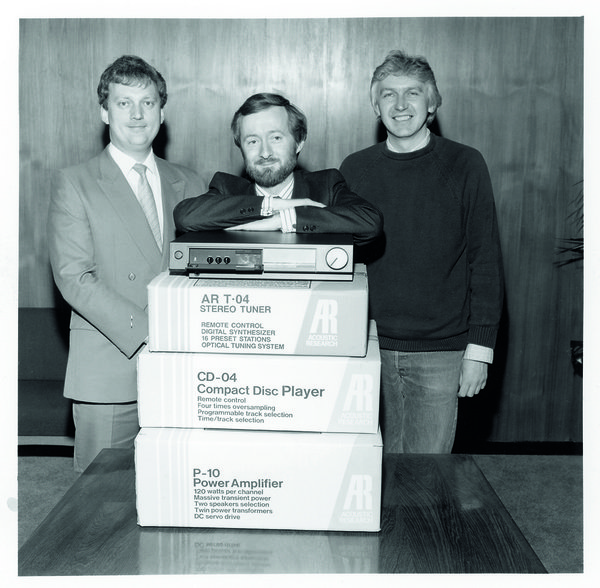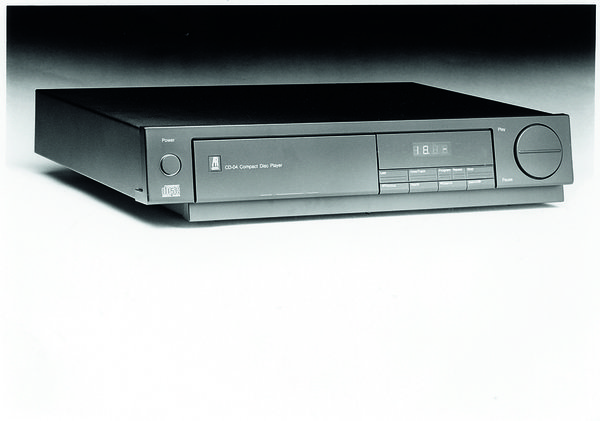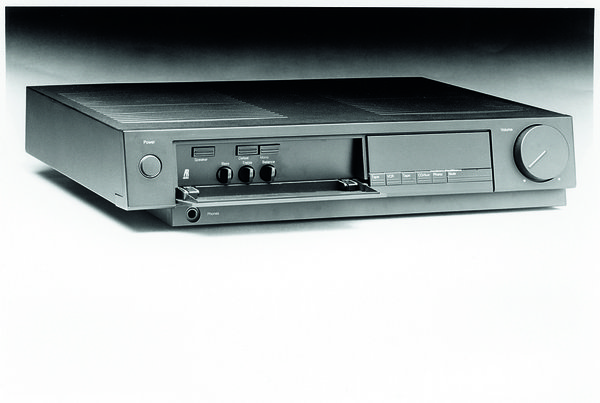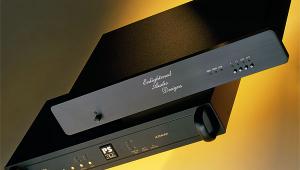Angle poise

 Acoustic Research launches a range of electronics that aims to combine good looks, useful facilities and fine sound. Ken Kessler hears a selection
Acoustic Research launches a range of electronics that aims to combine good looks, useful facilities and fine sound. Ken Kessler hears a selection
For as long as hi-fi has existed, consumers have been forced to choose between pure sound quality and ergonomic/aesthetic delight. In short, the best-sounding equipment has always been either spartan, ugly, expensive, or simply a pain in the butt to live with or to use.
Conversely, the best-looking, most facility-laden products have been sonic compromises or too expensive for mass-market appeal. What it has meant is that a whole market segment remains to be addressed: components that are good-looking, easy-to-use and fine-sounding, at realistic prices.
We can all name products that deal with two or three of those points, but Acoustic Research has done the impossible, and created a lineup which is - remote-controllable turntable and tape-deck aside - the first to satisfy on all levels.
 The CD-04 CD player [top], T-04
tuner [middle] and A-06 integrated amp
were part of a nine-strong series and
could be used stacked or side by side
The CD-04 CD player [top], T-04
tuner [middle] and A-06 integrated amp
were part of a nine-strong series and
could be used stacked or side by side
Proof Of Concept
What we are examining here, then, are not so much new models as a new concept. The range, consisting of two integrated amps, three receivers, a tuner, a CD player and a pre/power combination, is AR's way of showing that they're still firmly committed to sound quality, but aren't stupid, like those who hide behind a banner of 'audiophilia', using it as an excuse to get away with pug-ugly, overpriced, ergonomic nightmares.
 HFN’s then
editor Steve Harris
(far right) poses
for a picture with
staff from AR’s
headquarters in
Houghton Regis,
Bedfordshire,
following the
launch of the new
components in
the UK
HFN’s then
editor Steve Harris
(far right) poses
for a picture with
staff from AR’s
headquarters in
Houghton Regis,
Bedfordshire,
following the
launch of the new
components in
the UK
Think Global
How did AR do what other manufacturers haven't been able to accomplish, regardless of the size of their R&D budgets? For starters, AR grabbed Mike Bartlett, a pivotal figure in the transformation of Rotel from a purveyor of undistinguished amplifiers into one of the hottest producers of good budget gear currently available. He knew good sound would work as a selling point in an environment where 'never mind the quality, feel the width' has been the rule. And it must be remembered that AR thinks in global terms, so the new range is the result of major input from the British wing of the company, the US parent operation, and manufacturing links it has in the Orient.
The sheet was blank, but the mandate was clear: produce a complete range that would hold its own sonically, for the purist element, while offering everything that the much larger real-world audience requires. Aside from avoiding the automation of any of AR's existing turntables and the introduction of an analogue cassette deck at this late date, the company thought of everything, right down to VCR readiness. (Do not be too surprised if, when DAT becomes a reality, AR adds a digital tape deck to the catalogue.)
To hook the customer once he or she passes the shop's portals, you have to provide favourable initial impressions; there's nothing harder than convincing the non-purist of the worth of some hideous superamp. AR accomplished this by hiring a top Boston-based industrial design firm to create a style that would work for all nine components. The result is a novel look which enables the products to be stacked vertically, or displayed horizontally, a look which is contemporary yet not so space-aged that it will date as quickly as the latest issue of The Face.
Additionally, the design incorporates mildly sloped fascias, providing the user with two options for vertical stacking. The units can either line up at the back, which gives a stepped look reminiscent of the Nakamichi Dragon's layered switches, or the fascia edges can be lined up, to create a delightful sloped working surface of supreme accessibility. And realising some users may want a conventional cassette deck to serve until AR does or doesn't go DAT, AR chose a width of 430mm. Finally, the colour is that now ubiquitous gunmetal grey, which is a sensible alternative to silver or black.
The family resemblance from piece to piece goes beyond the dimensions, colour and sloped panel. All models, including the separate power amp, have a large diameter knob at the extreme right (it acts as a button on the CD player), an on/off button on the extreme left, and uncluttered expanses between. Depending on the unit, the right half will bear some form of display panel (CD, tuner, receivers) or press buttons (integrateds, preamp). The left half contains swing-down panels hiding either the minor controls or the CD tray; the power amp and the tuner sport a full-width fixed panel.
 The CD-04
was based on
Philips’ 14-bit/4x
technology. The
knob selected
play/pause while
buttons below the
time/track display
window selected
programming and
cueing modes
The CD-04
was based on
Philips’ 14-bit/4x
technology. The
knob selected
play/pause while
buttons below the
time/track display
window selected
programming and
cueing modes
Taking The Stage
Because the new range is being introduced in stages, for this review I was only able to examine the two integrated amplifiers, the tuner, and the CD player. But when you think about it, these are likely to be the most popular products in our market, as receivers are total stiffs as far as the UK is concerned (it seems that these days only the Yanks buy them in great numbers).
The separate pre/power package, while hardly exorbitant in price, is certainly less remarkable than a £249 integrated amplifier that will drive the power-hungry Celestion SL600 speakers as if they were KEF 'C's [see p120]. I did get to examine the rest of the range at CES, and the descriptions of their facilities, and have every reason to believe that they'll prove as comprehensive and novel as the units to hand.
If it weren't for the tininess of the average mind, AR wouldn't have needed to even suggest a power rating for the £249 A-06 amplifier. While the box and brochure say 60W per channel, the amplifier behaves like some £1000 separate power amp - but with the savings of £750 and a comprehensive preamp thrown in. The A-06 offers everything you're likely to need, including both MM and MC phono stages, CD, tuner and auxiliary inputs, facilities for two tape decks in both directions, two VCRs (including visual), defeatable tone controls, mono/stereo select, balance, mute, headphone socket, and speaker on/off.
Meanwhile, the back sports binding posts that will accept bare wire, spades or bananas, phono sockets for all of the above (gold-plated for LP), the MM/MC selector, sockets to separate pre from power for the insertion of an equaliser or other outboard unit, and a socket for connecting the amplifier to the remote control circuitry.
 The A-06 amp saw
the on/off switch,
source selectors
and mute given a
green LED to
indicate status. All
non-LED-equipped
controls were
hidden by a door
The A-06 amp saw
the on/off switch,
source selectors
and mute given a
green LED to
indicate status. All
non-LED-equipped
controls were
hidden by a door
Remote Thinking
The latter is the only confusing thing, because AR has cooked up some complicated arrangement which gives you a remote with the purchase of a tuner, CD player, or two of the receivers, but the remote only works on the A-06 if you add the tuner - in which case you have two remotes, because one came with the CD player. It's kind of screwy, but I suppose it's better than having to write a review about a range totally above criticism.
 Edgar
Villchur, who
founded US
company Acoustic
Research,
photographed in
October 1988. He
is most famous for
developing the
acousticsuspension
loudspeaker in
1954 and
suspended
subchassis
turntable in 1961
Edgar
Villchur, who
founded US
company Acoustic
Research,
photographed in
October 1988. He
is most famous for
developing the
acousticsuspension
loudspeaker in
1954 and
suspended
subchassis
turntable in 1961
Power Sharing
The attention to detail is evident through such touches as the above-mentioned gold phono sockets, and a volume control which, when operated by the remote, works via a motorised pot instead of nasty digital circuitry. The baby sister A-04, rated at 40W/channel and selling for a paltry £159, looks identical, but lacks facilities for one of the tape decks, one of the VCRs, and the remote operation of the volume.
Removing the covers reveals that, although the amps share the same motherboards and overall circuit configuration, the A-06 contains twin power supplies instead of the A-04's shared PSU, the motor behind the volume pot, and finned heatsinks being some 40% larger than the A-04's. In fact, the twin power supplies and heatsinks occupy roughly a third of the space.
Construction in both units was to a high standard, and very tidy considering that there's a huge cluster of cabling crossing the unit from the remote-in socket to the front-mounted board containing the switches. Additionally, the on/off switch and each of the source selectors and the mute have a dedicated green LED to indicate status. All of the non-LED-equipped controls are behind the door.
Cd-04 Cd Player
The CD-04, based on Philips' 14-bit/ 4x OEM guts, has had the analogue stages tweaked by AR. Shame it couldn't have goosed the slow-death, achingly familiar Philips transport. Whatever, the big knob selects play/pause, while buttons below the time/track display window select the programming and cueing modes. Everything except for programming is duplicated on the remote. (The remote, which I was only able to try with CD, performs all the functions on the tuner, as well as source select on the integrated amplifier, preamplifier, or receiver.)
As with other Philips-based players, a door swings down to allow the disc tray to exit. It rattles and scrapes, and - if I weren't too concerned about looks - I'd smear Vaseline all over the top of the door to silence its travel.
These items were used with the Celestion SL600s on Partington stands, the AR Legend turntable/arm, and cartridges of every stripe from RATA, Goldring, Ortofon, Linn, Audio-Technica, and others. As for my musical diet, it included the Telarc Sampler CDs and albums on both vinyl and CD, ranging from John Lennon/Yoko Ono's Double Fantasy [Geffen 299131-2], Cuff Bennett & The Rebel Rousers' Got To Get You Into My Life [See For Miles CM108], Sopwith Camel's The Miraculous Hump Returns... [Edsel XED205], and Lil' Ed And The Blues Imperials' Roughhousin' [Sonet SNTF966].
Why, you might ask, would I test a £249 amp and a £269 CD player with a pair of speakers costing more than the two units combined? Isn't it more likely that such a chain would terminate in something around £200-£300, like one of AR's own models? That will probably be the case, but I've got this recently-inaugurated love affair with the '600s, now that I've heard what they'll do with a couple of hundred tube watts, and I wanted to challenge the AR electronics - though not so unfairly as to tie them to a 1ohm load. While the '600s are hardly a Twilight Zone-type of load, they suck up the juice, so what better way to find out how the A-06 sounds when clipping? I never did get it to clip.
Listen: I came to this unit fresh after a session with the superb Musical Fidelity A100 in the same system, as well as experiencing a couple of weeks with the SL600s being driven by Roy Grant's 100W valve monoblocks. I had learned in short order just how good these speakers are for revealing the sonic signature of any piece in front of them, hence their use as the speakers for this review. Good Lord, did this amp make them sing!
Deep Cuts
Levels were never a problem. Even the A-04 did a respectable job, but it's not a match I'd recommend if you have a penchant for bleeding ears. When the A-04 clipped, things went soggy rather than edgy, but it was audible enough to suggest that the smaller amp preferred speakers with a few dB higher sensitivity.
Bass was simply glorious, extended enough to obviate the need for a subwoofer in a room measuring 3.5x4.25m. Extension was deep enough to cope with the explosion on Emitt Rhodes' 'The Man He Was', and with control just right for the bass-drum smacks on Papa Doo Run Run's version of 'Surfin' USA'. The midrange? Clear and open, with no congestion or nasality on vocals. This, allied to a sweet, detailed top end, led to the full exploitation of the SL600s' marvellous imaging capabilities.
T-04 Tuner
The tuner is simplicity itself, so simple in fact that the section which on the other units hides minor controls is fixed in place. The back contains phono sockets for signal (line) out, terminals for an AM or 300ohm FM aerial, a coaxial socket for 75ohm aerial, and an output for rigging the remote circuitry to the rest of the system. The fascia houses the on/off switch, press-buttons for eight AM or eight FM stations, a memory button to programme the stations, a mono button, auto/ manual tuning, and AM/FM select.
Manual and auto-seek tuning is via a large rotary control (as well as through the handset), instead of press-button auto-seek, as the team responsible for ergonomics soon learned that people still like the feel of such controls, whether operating an all-analogue tuner or a digital device such as this. The window, which is illuminated in green, shows the waveband, the station number, whether or not the signal is in stereo, signal strength via five bars, and a sixth bar to show that the signal is locked. Meanwhile, each of the press buttons is illuminated to show status and chosen preset.
The T-04 delivered hiss-free, clean, and open sound in keeping with the standard set by the other components in this system. Stereo spread was just dandy, male voices were refreshingly free of chestiness, and sibilance was kept well down. The tuner had no difficulty pulling in weak stations, holding on to them once the locking light glowed.
With tuner standards so high these days, it's hard to feel the earth move listening to the radio, except when live broadcasts render the transmission superior to encoded media, so forgive me if I don't do handstands over this item. It did everything it was supposed to do in the context of this system, meeting the criteria of aesthetics, ease of use, sound and value for money. A remote control tuner for £205? Are you gonna complain? Am I?
Taking My Turn
Well, yes. Much though I prefer rotary tuning, I reckon it hinges on the feel, not just vis-à-vis pushing buttons. The knob on this was sloppier than I prefer (eg, the knob on the Marantz 10B), and the buttons weren't as positive as on the CD player (which may just be minor sample variation). As for missing facilities, I suppose some will want Long Wave, but other than that, I couldn't find anything it wouldn't do on which I'd place any real value.
There were two minor weaknesses in the system that were evident regardless of source, and I emphasise they were trivial in the context of the price. After those sessions with the Musical Fidelity A100, I was spoiled by its superlative top-end. By comparison, the A-06 and the A-04 showed subtle graininess, mostly apparent when handling strings, and of a nature associated with early CD. It was not aggravating - edginess is not a trait I'd associate with either amp - but then I'm paid for finding these chinks in the armour, however small.
The other point of criticism was slightly reduced front-to-back depth, particularly relative to the maximum capabilities of the Celestion SL600s when driven by over-the-top hardware. I feel like a real pedant for even mentioning these traits when, overall, the products are so thoroughly well-conceived and capable of such sterling performance, allied to prices that even Roy Hattersley would find hard to criticise.
A-04 And A-06 Amplifiers
The A-04 is, by degrees, a baby A-06. The extra £90 does, however, buy a lot more than remote-controllable volume and extra inputs for tape and VCR. In some ways, the lower powered amp is even sweeter, due to less aggressive transient edges, but I'll be damned if I'm going into print twice in one issue praising inaccuracy as a virtue. But there's no denying the gains made from the A-06's extra headroom - which seems like a lot more than 1.5dB - and far more solid lower registers. Then again, £90 is equivalent to 18 LPs or just shy of nine CDs, so don't feel that you're a martyr if priorities dictate the less-expensive purchase. The A-04 is, at its price point, as much of a success as the A-06. It's just that the A-06 is, if you can afford it, worth the extra.
Operationally, both amps were delightful, and you can tell that the positioning and feel of the controls wasn't accidental. If I have any reservations about the setting up of an A-06-based system, it would only be that I preferred the MM input to the MC option. Fortunately, this amplifier would do justice, in MM mode, to MCs of fairly healthy yield, but do try the cartridge of your choice before assuming that it will work satisfactorily. The main demerit concerning the MC stage was a minor congestion, which affected ambience; I found the added noise of using MCs into the MM setting less destructive than the congestion.
I wish I could say that the CD-04 gave me as much pleasure, but it didn't on the grounds that it doesn't stand out among the competition the way the amps do. Still, that's a compliment, because it is an outstandingly good CD player; I found it less clinical than the Philips CD160, and was able to overlook the horrid transport because - in context - the CD-04 is the perfect synergistic choice for owners of the A-06 or A-04. Hell, for £269 with remote, it's a bargain, lacking only some of the more facile gimmicks, like shuffle mode, to make it the king of the budget CD players.
It coped beautifully with the discs I fed it, doing justice to both the software and the rest of the system. As I had the CD-04 at the same time as the California Audio Labs' Tempest, I was able to compare it to a leading-edge machine costing ten times as much. It held its own, failing to match the Tempest's soundstaging and bass texture, but easily justifying its tariff of only 10% of the Tempest's price.
Acoustic Research has done a great job with this player and it has my nod as the first original and fresh-looking affordable CD player since the format began. You don't have to buy it just so it will match the rest of the system. This machine deserves attention for its own virtues.
Conclusion
As a system and as a concept the new AR electronics represent a watershed in consumer hi-fi. I can't stress enough how important this move is in real market terms. On a personal level, I no longer have to apologise to non-tweaky friends who want a good looking, affordable, all-singing-all-dancing system and fine sound quality to boot.
























































